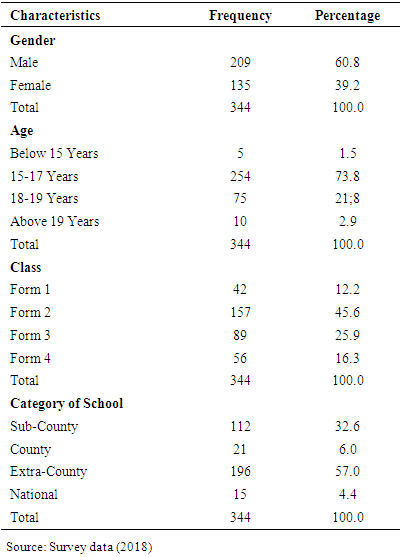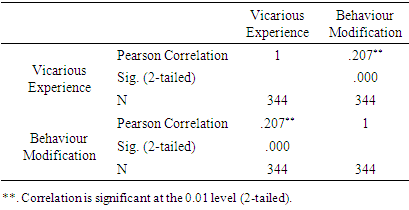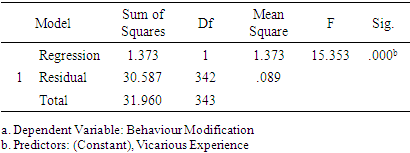-
Paper Information
- Paper Submission
-
Journal Information
- About This Journal
- Editorial Board
- Current Issue
- Archive
- Author Guidelines
- Contact Us
International Journal of Brain and Cognitive Sciences
p-ISSN: 2163-1840 e-ISSN: 2163-1867
2020; 9(1): 9-15
doi:10.5923/j.ijbcs.20200901.02

Vicarious Experience and Delinquent Behaviour Modification: Evidence Among Students in Secondary Schools in Kenya
Tom K. O. Onyango1, Peter Jo Aloka2, Pamela A. Raburu2
1Phd Student in Guidance and Counselling, Jaramogi Oginga Odinga University of Science and Technology, Bondo, Kenya
2Jaramogi Oginga Odinga University of Science and Technology, Bondo, Kenya
Correspondence to: Peter Jo Aloka, Jaramogi Oginga Odinga University of Science and Technology, Bondo, Kenya.
| Email: |  |
Copyright © 2020 The Author(s). Published by Scientific & Academic Publishing.
This work is licensed under the Creative Commons Attribution International License (CC BY).
http://creativecommons.org/licenses/by/4.0/

The study investigated the relationship between Vicarious Experience and Delinquent Behaviour Modification among secondary school students. The study employed concurrent triangulation design. The sample size comprised of 374 students, 8 deputy principals and 7 teacher counselors. Vicarious Experience Scale and Behavior Modification Questionnaire for Students were used to collect quantitative data. The interviews and Focus Group Discussions were used to obtain qualitative data. The reliability co-efficient reported was a high of 0.759 (vicarious experience questionnaire). Pearson Product Moment Correlation Coefficient was used to analyze data. There is statistically significant positive correlation between vicarious experience and behaviour modification among secondary school students (n=344; r = .207; p<.05). Teacher counsellors should expose students to environments that would enhance batter vicarious experiences.
Keywords: Relationship, Vicarious Experience, Delinquency, Behaviour Modification, Secondary school, Students
Cite this paper: Tom K. O. Onyango, Peter Jo Aloka, Pamela A. Raburu, Vicarious Experience and Delinquent Behaviour Modification: Evidence Among Students in Secondary Schools in Kenya, International Journal of Brain and Cognitive Sciences, Vol. 9 No. 1, 2020, pp. 9-15. doi: 10.5923/j.ijbcs.20200901.02.
Article Outline
1. Introduction
- Behaviour modification refers to the technique or treatment procedure used to change behaviour by altering a person’s current environment to help the person function better in everyday life (Pear & Martin, 2003). Behaviour modification focuses on using a principle of learning and cognition to understand and change people’s behaviour. Behavior modification is a psychotherapeutic intervention primarily used to eliminate or reduce maladaptive behavior in children or adults. While some therapies focus on changing thought processes that can affect behavior, for example, cognitive behavioral therapy, behavior modification focuses on changing specific behaviors with little consideration of a person’s thoughts or feelings. The progress and outcome of the intervention can be measured and evaluated. A functional analysis of the antecedents and consequences of the problem behavior(s) must be identified. This leads to the creation of the specific target behaviors that will become the focus of change. Then, certain variables can be manipulated via reinforcers and punishments to change problem behavior(s). The goal is to eliminate or reduce the maladaptive behavior (Scott & Cogburn, 2019).Behaviour change interventions should be underpinned by theories and models as psychological processes can provide insight into the mechanisms that contributed to intervention effectiveness if successful changes are observed, and allow for replication (Michie & Abraham, 2004). It has been proposed that elf-efficacy beliefs are constructed from four main sources: enactive mastery experience, vicarious experiences, verbal persuasion, and physiological and emotional arousal (Bandura, 1977a). Self-efficacy beliefs can be derived from vicarious experience. For many types of activities, there are no objective measures of adequacy or people do not have any previous experience on which to base their judgements of competence (Bandura 1997). Self-efficacy is a person’s belief that she is capable of performing a particular task successfully (1997). As French (2013) suggests, causal association criteria in that this experimental study induced changes in the intervention group only and not in the control group, change in self-efficacy occurred before participants increased their walking, there were large changes in self-efficacy and walking behaviour, the strength of association between the two was strong, and formal mediation testing showed that self-efficacy mediated the effects of the intervention.This study was informed by the Self-Efficacy Theory Bandura’s self-efficacy theory. According to this theory, vicarious experience is one of the main sources that influence the efficacy of the individual teacher and alter efficacy beliefs through transmission of competencies and comparison with the attainment of others (Bandura, 1997). Multiple studies have provided evidence of the role that vicarious experiences play in influencing self-efficacy (Bandura, 1986). Literature on vicarious experiences and behavior change exists. Wagler (2011) in an American study reported a positive impact of vicarious experiences on pre-service science teaching efficacy. Ashford, Edmunds, and French, (2010) study reported a significant difference between interventions that included this strategy and those that did not (Z= 4.07, p<0.001) with vicarious experience producing larger effect size estimates (d=0.32) compared to those not including vicarious experience as a strategy (d= 0.11). Qu, Ling, Heynderickx and Brinkman (2015) study showed that the expressed attitude of virtual bystanders towards the participants affected their self-efficacy, and their avoidance behavior. Otengei, Kasekende and Ntayi (2017) in Uganda suggested vicarious experience as an alternative route to stimulating a particular form of career motivation. Bartle & Harvey (2017) reported that previous experience (particularly personal experience of breastfeeding) explained a significant amount of variance in attitudes, subjective norm, and self-efficacy. Otengei, et al (2017) study indicated vicarious experience as an alternative route to stimulating a particular form of career motivation. Bandura, (1977) also reported from microanalyses of enactive, vicarious, and emotive modes of treatment that support the hypothesized relationship between perceived self-efficacy and behavioral changes. Schyns, (2004) reiterate that vicarious learning, is regarded as possibly being responsible for this effect. Loo, and Choy (2013) study showed that self-efficacy sources were correlated with mathematics achievement scores as well as cumulative GPA of electronics-related engineering diplomas. Wilde, Natalie, and Anne Hsu (2019) showed individuals with low general self-efficacy to find vicarious experience information significantly less beneficial for their self-efficacy in completing a set task when compared to others with high general self-efficacy. Gülru Yüksel (2014) longitudinal study in Turkey found that pre-service teachers seem to depend more on enactive mastery experience and social persuasion than on vicarious experience and affective state as sources of information. Mazziotta, et al (2011) reported that vicarious contact improves attitudes towards the out-group and increases participants’ willingness to engage in direct cross-group contact. Qu et al (2015) study showed that the expressed attitude of virtual bystanders towards the participants affected their self-efficacy, and their avoidance behavior. Furthermore, the experience of witnessing bystanders commenting negatively on the performance of other students raised the participants’ heart rate when it was their turn to speak.From the reviewed studies, most of them have been either quantitative or qualitative in nature, but the present study adopted a mixed methods design. The government of Kenya expects secondary schools to use more of guidance and counselling to instill discipline among students rather than punishment to enforce the same. Schools play an important role in the socialization process of the young people from where they learn to regulate their own conduct, respect others, and manage their time responsibly and thus becoming responsible citizens. However, we have an increase in the number of delinquent behavior in Rongo Sub County (Personal communications, 2018). Despite students undergoing guidance and counseling services, this problem continues to persist. The present study investigated the relationship between Vicarious Experience and Delinquent Behaviour Modification among secondary school students.
2. Research Methodology
- Research design and study participantsThe study employed concurrent triangulation design. The study employed a mixed approach by adopting both the qualitative and quantitative data. Creswell (2012) notes that mixed methods research approach utilizes in-depth contextualized and natural but time consuming insights of qualitative research coupled with the more efficient but less rich quantitative research. The sample size comprised of 374 students, 8 deputy principals and 7 teacher counselors. Research toolsThe Vicarious Experience Scale was used to collect data. The Behavior Modification Questionnaire for Students was also used to estimate the extent of behavior change among the counselled students. This helped with measuring how much these are in the students who have undergone guidance and counselling. These were rated using the scale of Strongly Disagree (SD), Disagree (D), Unsure (U), Agree (A) and Strongly Agree (SA). Cronbach’s alpha coefficient analysis was a high of 0.759 for vicarious experience questionnaire was reported.Data collection proceduresEthical clearance was first obtained from National Commission for Science Technology and Innovation in Kenya. Thereafter, the letter of introduction was presented to the County Education Office then to the Sub-county Education office. The principals of the sampled schools were also requested for permission to carry out the research in their schools. The questionnaires were administered in school at a time the students were not attending to lessons or assessments. The questionnaires took under 30minutes each to complete. All questionnaires were collected after completion, and the respondents appreciated for their cooperation and participation. Interviews and Focus Group Discussions took 30-45 minutes to undertake.Data analysisStatistical methods are mainly used for analyzing data in order to discuss the relationship between variables (Babbie, 2007). The data was analyzed by entering the data into SPSS version 25 and performing a Pearson Correlation with vicarious experience against success in behaviour modification among students. In investigating the views of the students on their vicarious experience, a Likert scaled itemed questionnaire was used. The items of the questionnaire were indicators of vicarious experience among secondary school students. The vicarious experience was investigated using three areas; adult, peers and self-vicarious experience. The responses were scored using a five point scale ranging from strongly disagree (1) to strongly agree (5). The scores were averaged to measure the respondents’ attitude on their level of vicarious experience. The student behaviour modification was interpreted from the summation of their characteristics as exhibited in indicators of behaviour after going through counseling services. The sampled students were provided with questionnaires with indicators of behaviour modification and were asked to rate their behaviour in regards to these characteristic. The qualitative data obtained was analyzed using the Thematic Framework (Braun & Clark, 2006).
3. Results
3.1. Background Information of the Student Respondents
- The study sought to investigate the background information of the students who took part in the study. The background information was well thought-out for the determination of whether the respondents were representative enough in terms of their demographic characteristics for the generalization of the results of the study. The demographic information investigated included age, gender, class and the school category of the students, as shown in Table 1.
|
3.2. Findings on the Relationship between Vicarious Experience and Delinquent Behaviour Modification
- The study examined the relationship between the level of vicarious experience and behaviour modification among secondary school students in Rongo Sub-County. To investigate this objective, first, descriptive statistics was used to investigate the views of the sampled students on their vicarious experience, followed by use of inferential statistics to test the hypothesis on the relationship between vicarious experience and behaviour modification.The Hypothesis was stated as follows:H01: There is no statistically significant relationship between vicarious experience and behaviour modification among secondary school students In order to test the null hypothesis, a Pearson Product Moment Correlation Coefficient was computed with scores on students’ vicarious experience as independent variable and behaviour modification as dependent variable. The scores of independent variable (vicarious experience) was computed from frequencies of responses by computing mean responses per respondents. Mean response across a set of questions of Likert scale responses in each item was computed to create a continuous variable, within an open interval of 1 to5, which is suitable for the use Pearson correlation and regression analysis, as explained by Johnson & Creech (1983) and Sullivan & Artino (2013). This was done after reversing the negatively worded statements, where high scale ratings implied high perceived students’ vicarious experience. Correspondingly, behaviour modification was computed in a similar manner from the student responses on its indicators. A significant level (p-value) was set at .05, where, if the p-value is less than 0.05, the null hypothesis would be rejected and conclusion reached that a significant difference exists. However, if the p-value is greater than 0.05, it would be concluded that a significant difference does not exists. Table 2 shows the SPSS output correlation analysis results.
|
|
|
|
4. Discussion
- The study findings indicated that there is statistically significant positive correlation between vicarious experience and behaviour modification among secondary school students (n=344; r = .207; p<.05). The model summary indicates that students’ level of vicarious experience accounted for 4.0% (Adjusted R2 =.040) of the variation in their behaviour modification. This finding indicates that 4% of the variability in behaviour modification among the secondary school students is as a result of differences in their level of vicarious experience. From the model, the slope coefficient for student vicarious experience is 0.085 (B=.085), suggesting that student behaviour is modified by .085 units for each one unit improvement in the level of vicarious experience among the secondary school students. Wagler (2011) indicated that variables of student ethnicity, student socioeconomic status and preservice teacher program placement were significant predictors of the preservice elementary teachers’ science teaching efficacy during their vicarious experiences. Ashford, Edmunds, and French, (2010) study reported that there was a significant difference between interventions that included this strategy and those that did not (Z= 4.07, p<0.001) with vicarious experience producing larger effect size estimates (d=0.32) compared to those not including vicarious experience as a strategy (d= 0.11). Qu, Ling, Heynderickx and Brinkman (2015) study showed that the expressed attitude of virtual bystanders towards the participants affected their self-efficacy, and their avoidance behavior. Otengei, Kasekende and Ntayi (2017) findings thus suggest observational learning (vicarious experience) as an alternative route to stimulating a particular form of career motivation (career identity). Bartle & Harvey (2017) reported that previous experience (particularly personal experience of breastfeeding) explained a significant amount of variance in attitudes, subjective norm, and self-efficacy. Otengei, et al (2017) findings thus suggest observational learning (vicarious experience) as an alternative route to stimulating a particular form of career motivation (career identity). Bandura, (1977) Study Findings are reported from microanalyses of enactive, vicarious, and emotive modes of treatment that support the hypothesized relationship between perceived self-efficacy and behavioral changes. Schyns, B. (2004) reported that vicarious learning is regarded as possibly being responsible for this effect.From the qualitative findings, the themes on the relationship between vicarious experience and behavior modification of secondary school students included positive befriending, role modeling, copying others’ styles and suppression of bad behavior. Loo, C. , & Choy, J. (2013) reported that vicarious experience was correlated with mathematics achievement scores as well as cumulative GPA of electronics-related engineering diplomas. Wilde, Natalie, and Anne Hsu. (2019) showed vicarious experience information significantly less beneficial for their self-efficacy in completing a set task when compared to others with high general self-efficacy. Gülru Yüksel (2014) found that pre-service teachers seem to depend more on enactive mastery experience and social persuasion than on vicarious experience and affective state as sources of information. Agostino Mazziotta, Amélie Mummendey, Stephen C. Wright. (2011) indicate that vicarious contact improves attitudes towards the out-group and increases participants’ willingness to engage in direct cross-group contact.Qu C, Ling Y, Heynderickx I, Brinkman W-P (2015) reported that, the experience of witnessing bystanders commenting negatively on the performance of other students raised the participants’ heart rate when it was their turn to speak.
5. Conclusions & Recommendations
- From the study findings, it was concluded that there is statistically significant positive relationship between vicarious experience and behaviour modification among secondary school students in Rongo Sub-County, with high level vicarious experience and linked to better behaviour modification among secondary school students. Likewise, an improvement in vicarious experience by one standard deviation results to improvement of behaviour modification by .207 standard deviations, as indicated by standardized beta coefficient of .207. it was concluded that although the influence is fairly small, there is statistically significant influence of vicarious experience on behaviour modification among the secondary school students. This denotes that secondary school students with high level vicarious experience is likely to exhibit high behaviour modification. From the study findings, it’s recommended that students need to be exposed to environments that would enhance batter vicarious experiences.
 Abstract
Abstract Reference
Reference Full-Text PDF
Full-Text PDF Full-text HTML
Full-text HTML



